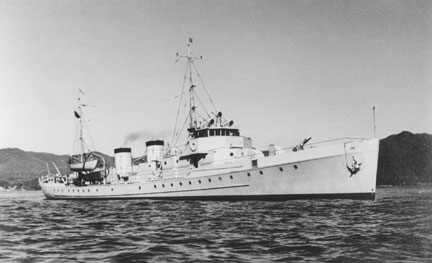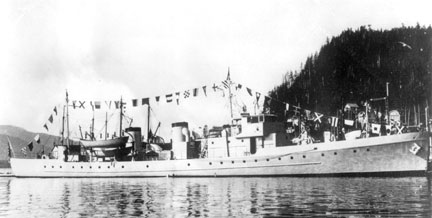Ruby E.
| Other Names: Cyane, Can Am | Date of Sinking: June 18, 1989 | |||
| Rig/Type: Former Coast Guard Cutter, Fishing Boat, and Salvage vessel | Cause of Sinking: Intentional for Use as Artificial Reef | |||
| Length: 165' | Breadth: 38' | Tons: 150 | Cargo: None | |
| Built:1934 by Lake Union and Dry Dock Machine Company of Seattle, Washington | Location: Off Mission Bay, San Diego | |||
| Coordinates: 117 16'36" W, 32 46'02" N | ||||
| Hull Construction: Steel | Depth: 85' | Visibility: 15-30' | ||

U.S. Coast Guard Photograph, courtesy of USCG Historian's Office.
History of the Ruby E
The Ruby E began her life as the Coast Guard Cutter named Cyane. The Cyane, known as WPC-105, was built in 1934 at the Lake Union and Dry Dock Machine Works in Seattle Washington. She was designed to intercept “rum runners” during prohibition years. The “WPC” boats were nicknamed the 165s for their length in feet and were supported by two massive diesel engines, which allowed for great speed despite its large size. The additional size was necessary to reach and pursue the rum runners that were operating along the entire West Coast. These rum runners would bring whiskey from Canada and wait offshore in their mother ships. At night, small boats would venture from local docks and rendezvous with the smugglers mother ships. Offshore, cases of liquor were sold for a very cheap price and the small boats would bring the liquor back to shore to be sold for an enormous profit. Rum running was an extremely lucrative and relatively safe trade especially during the early days of prohibition. The addition of the Cyane and other ships of her class, helped put pressure on the smugglers making it harder to sell their liquor and avoid prosecution.
However, true to form, she was completed after prohibition ended and the Cyane was not needed for its original purpose. The Coast Guard did find a use for the new ship and she soon was working off the Alaskan coast. She served dutifully for 16 years, mainly based in Ketchikan Alaska, until she was officially decommissioned in 1950. Her career included Bering Sea and Alaskan Anti-Submarine Patrols during WWII.
In 1954, she was sold to Birchfield Boiler Company for $8,156.00 as part of an auction of four retired ships. They renamed her the Can Am and converted the cutter into a fish-processing vessel. Her crew berthing compartments were made into holds and a crude refrigeration system was installed to keep the catch cold. The second (aft) smoke stack and the rear radio mast were also removed to allow more deck space. When the refit was completed, she was sent to fish the waters off Central and South America. In a twist of irony, the former law enforcement vessel was reportedly impounded by customs officers in South America for drug smuggling
.
U.S. Coast Guard Photograph, courtesy of USCG Historian's Office.
Sold again, the ship was renamed the Ruby E and outfitted as a salvage vessel. Her new owners ran into financial difficulties and could not repay their bank loans. The Ruby E was seized as a bank repossession and sat in San Diego harbor until it was purchased by the San Diego Tug and Barge Company.
Her new owners decided to remove her fittings and machinery, and sell the hull for scrap. Al Bruton, a local San Diego diver, convinced the Tug and Barge Company to donate the stripped vessel to wreck alley, a dive attraction and artificial reef off Mission Bay. Spearheaded by Al and the local diving community, the Ruby E was environmentally cleaned and made accessible to divers by cutting holes in various parts of the ship. These holes made the ship “diver safe” by allowing easy entry and exit to the holds, officer’s quarters, and engine room. Additionally, doors were removed or welded open to prevent entrapment. Once completed, the Ruby E was ready to be sunk and take her place near the El Rey, a kelp cutter sunk two years earlier.
The morning of July 18, 1989 marked the day when the Ruby E would begin a new life as an artificial reef. She was towed to a planed location of Mission Beach and anchored. The sea cocks were opened and it was hoped she would fill up with water and sink. The spectators watching the sinking waited and watched. By noon, the ship was still afloat with only a slight starboard list. Unknown to planers, two secret compartments were hidden in the bulkheads fore and aft of the engine room. These sealed compartments were used to hide drugs during its smuggling days and now prevented the ship from sinking.
Local lifeguards brought several large pumps onboard to speed up the flooding. By 3 PM the Ruby E's stern was very low in the water but still afloat. Finally, at 3:30 PM the lifeguards were forced to abandon the Ruby E as she began to sink. With her stern leading the plunge, she rolled briefly onto her starboard side as seawater approached her amidships. Suddenly, her bow and forward compartment shot straight up into the sky, before slowly sinking to the bottom. The Ruby E was gone and the cheers of those who waited all day and bubbling foam were all that remained.

Diving the Ruby E
Unbelievably, she sits upright and intact on the bottom with only the slightest list to the port side. All areas of the wreck except the bilge are easily accessible and the wreck is a pleasure to dive. The bow of the Ruby E points in a northerly direction and lies in about 90 feet of water.
The wreck can be located by finding the yellow Department of Fish and game buoy, which marks the bow. The layout of the wreck provides a number of dive opportunities to completely explore the wreck. Working aft from the bow, there are holes burned into the deck exposing a hold and the anchor chain locker. The bridge and wheelhouse are readily accessible and are one of the high points of the dive. A plaque, dedicating the wreck and acknowledging its supporters is centrally located on the front of the bridge superstructure. Inside the superstructure, are the remains of the chart locker and the captain’s quarters. Holes cut into the port and starboard side of the ship below the bridge allow access into the crew’s berthing quarters. The engine hatches have been removed which offer divers a view of the engine room with the massive engines still in place. The port engine has the heads off the top of the motor exposing the cylinders, while the starboard engine is completely intact. On days with good visibility, the light streaming into the engine room is an amazing sight. The aft deck has several open holds leading to the stern rail, where the letters “Ruby E” were once visible. If conditions are just right you might catch a glimpse of the ships twin bronze propellers sticking out of the sand, but as time goes by they are getting more difficult to find.
The wreck is in great condition and is almost completely covered with anemones and marine encrustations. The Ruby E has been down for almost 12 years and the harsh environment has taken its toll. There are areas where the sides of the superstructure and hull are getting quite thin, but the wreck remains intact. The wreck is still fairly diver safe, but caution should be taken when penetrating, as sharp rusted metal is all around. Removal of any artifacts is prohibited, as this site is an artificial reef. The site is in an area with heavy boat traffic and care should be taken to ascend and descend via the buoy or anchor chain.
Visibility averages 20 feet, but some days, in the winter can offer exceptional 40 to 60 foot visibility. Opportunities for photography are endless with the wreck itself and the amount of marine life living on or around the wreck. The Ruby E has truly become an oasis in the sand flats of Wreck Alley, living up to the name of artificial reef.
Starboard bow shot of the Ruby
E. |
The Ruby E, just
prior to its sinking |
A plaque on the Ruby E. (courtesy Bob Gladden) |
|
| The Stern of the Ruby E. (courtesy Bob Gladden) | |
The bow of the Ruby
E., quickly covered by growth |
For pictures and more information, check out: http://divebums.com/main.html or:
| Like to learn more about this wreck? Visit our Guest Page to submit your inquiry. |
